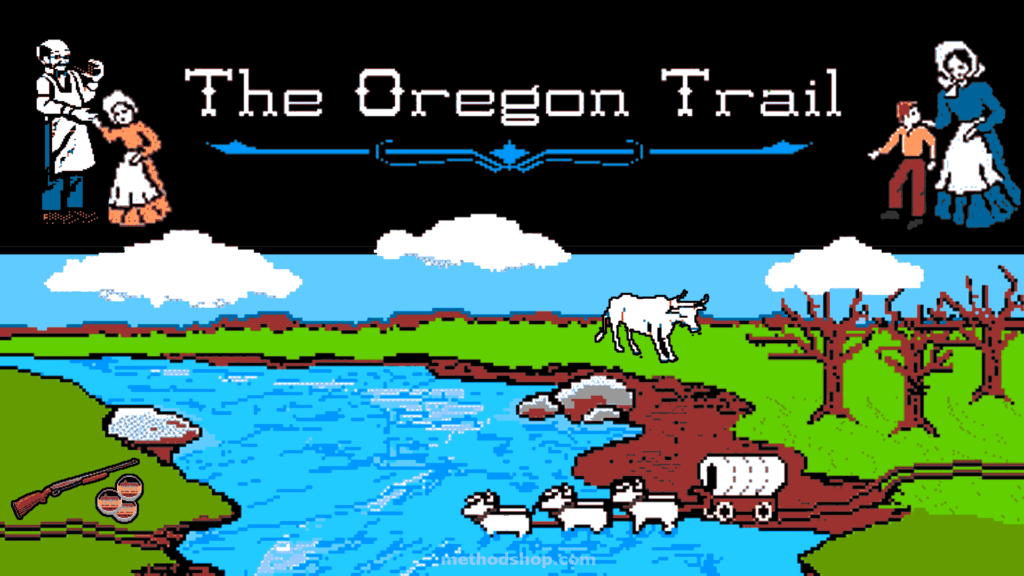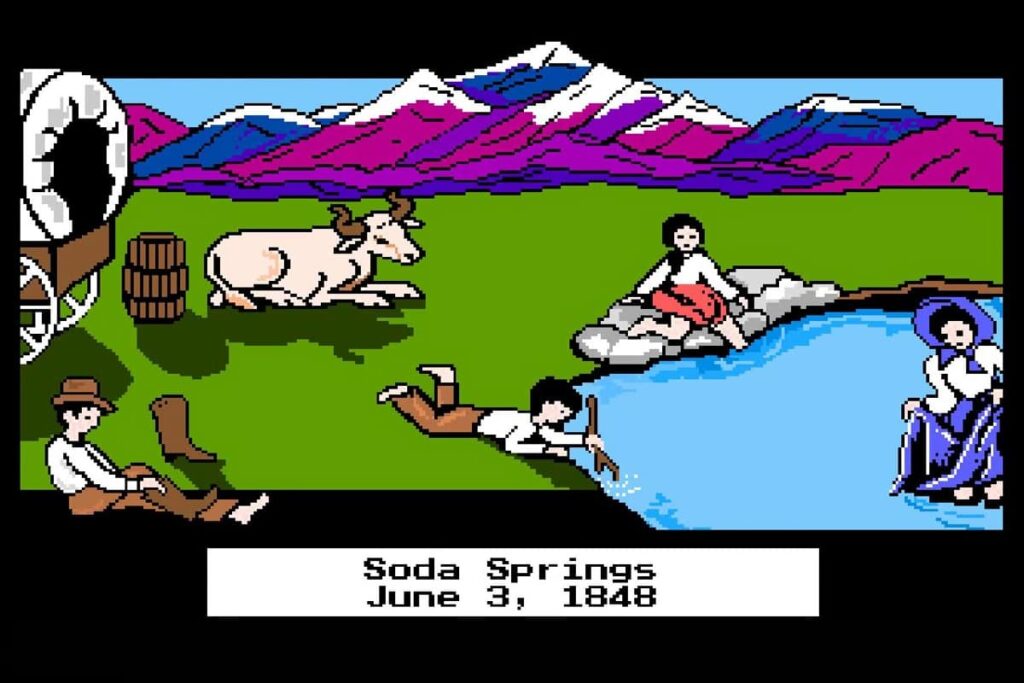Since its debut in the early 1970s, The Oregon Trail has captured many players’ imagination. Created by Don Rawitsch, Bill Heinemann and Paul Dillenberger as an instructional computer game to recreate American settlers’ treacherous trek across Oregon in 1848-49 to reach California, this iconic instructional computer game has left an indelible mark on many young lives – both those playing it at home or school and creating lifelong memories while engaging in educational gaming environments.
No one could overstate The Oregon Trail’s impact in educational gaming history. By successfully merging instruction and fun into a single experience, this pioneering educational game set a precedent that other educational games followed later. Even after numerous revisions and upgrades as well as platform modifications were implemented over time, its popularity remains undiminished and will remain an iconic classic for years to come.
The Origins Of The Oregon Trail
Don Rawitsch, Bill Heinemann and Paul Dillenberger collaborated in creating The Oregon Trail. When Rawitsch was assigned a course on American West expansion in 1971, he decided to create a board game as a means of keeping his students’ attention. With help from Heinemann and Dillenberger (his math instructors housemates), Heinemann helped turn this concept into a computerized teletype machine game which quickly gained traction with pupils. They quickly believed they had achieved something truly exceptional when pupils took an immediate liking to The Oregon Trail.
Rawitsch began working for Minnesota Educational Computing Consortium (MECC), a company responsible for providing educational software to Minnesotan schools, in 1974. When he delivered The Oregon Trail to MECC they quickly recognized its potential and decided to distribute it among schools introducing many pupils for the first time to instructional gaming.
The Oregon Trail had a profound effect on Apple II computer system. MECC began developing an adaptation of The Oregon Trail specifically tailored for Apple II in early 1980, which quickly became well-liked as an affordable educational platform. Due to The Oregon Trail’s success there, Apple II cemented its position as a go-to choice among classrooms across America; consequently attracting an even broader audience while solidifying its legacy and becoming part of daily curriculum instruction.
Gameplay Mechanics And Learning Experience
Players take on the role of waggon leaders in The Oregon Trail, leading a group of settlers from Independence, Missouri, to the Willamette Valley in Oregon. Players manage resources and make crucial decisions throughout their trek – all necessary elements of survival for an enjoyable journey!
Hunting food is one of the main challenges encountered during any voyage. In order to provide sustenance for their party, players must strategically hunt wild species such as buffalo, deer and rabbits. Players also face other challenges like river crossings when making decisions between fording the water, caulking waggon or paying ferry fees; each decision entails risks and potential outcomes of its own.
Players must deal with potential dangers such as sickness. Settlers could become infected with dysentery or cholera, or be exposed to snake bites which, left untreated, may prove fatal. By teaching players the importance of managing resources effectively during an adventure like this one, this game teaches valuable lessons on resource allocation.
The Oregon Trail provides educational benefits that go far beyond resource management and judgment. By immersing players in the struggles endured by American pioneers during mid 19th century America, this game offers invaluable historical context and develops problem-solving and critical thinking abilities while imparting more knowledge of struggle endured at this critical moment in American history.
Memorable Moments And Challenges
The Oregon Trail is full of interesting challenges and unforgettable experiences that have drawn players in for decades. These obstacles have entertained gamers while also teaching them important lessons about the dangers pioneers encountered when emigrating to the west.
- Hunting for food and the introduction of the buffalo hunting mini-game: The hunting mini-game is one of The Oregon Trail’s most recognizable features. To feed their group, players must go on the hunt, utilizing their meager ammunition to kill buffalo, deer, and rabbits. Players learn the value of resource management through an enjoyable and unique experience that combines the thrill of the hunt with the need to save ammo.
- River crossings and the strategy behind choosing the safest route: River crossings are another memorable obstacle on The Oregon Trail. The choice of whether to ford the river, caulk the wagon, or pay for a ferry is up to the players. Risks associated with each choice include drowning, material harm, and monetary outlay. This component of the game urges players to consider all of the possible outcomes of their choices because making the wrong selection could end badly for their party.
- The perils of illness: dysentery, cholera, and snake bites: The Oregon Trail is well-known for depicting the harsh realities that faced settlers, such as how common diseases and injuries were. Players are responsible for managing their party’s health, attending to conditions including dysentery, cholera, and snake bites. If not treated, these ailments can soon take the lives of settlers, giving the game a sense of urgency. This element of The Oregon Trail emphasizes the difficult circumstances the settlers had to endure while on their journey and teaches players the value of appropriate medical care and resource management.
The Evolution Of The Oregon Trail
The Oregon Trail has undergone various alterations and modifications since its debut in the early 1970s, assuring its ongoing relevance and appeal to players of all ages.
- The many versions and adaptations over the years: The Oregon Trail has seen numerous iterations over the years, all of which built on the foundation of the first game. To accommodate players’ changing tastes and preferences, these adaptations have added new gaming components, updated graphics, and extended platforms.
- Updated graphics, new gameplay features, and platform expansions: The Oregon Trail has changed to keep up with technological advancement. Simple text-based graphics were used in the game’s early iterations, but more eye-catching, colorful designs were added in later versions. To improve the player experience, extra mini-games and more decision-making possibilities have been added to the gameplay. The game is now accessible on a variety of platforms, including PC, Mac, and even mobile ones, in addition to its original Apple II platform.
- The transition from a text-based game to a multimedia experience: The Oregon Trail’s progression from a text-based game to a multimedia experience is among its most significant features. Richer graphics, sound effects, and even voice acting have been added to the game as a result of advancements in technology, giving players a more immersive and captivating experience. This change has made The Oregon Trail a beloved classic that still appeals to contemporary audiences.
The Oregon Trail has maintained its popularity throughout the years in large part due to its capacity to adapt and change over time. The game’s enduring appeal and the priceless lessons it teaches players about history, resource management, and decision-making are testaments to its ageless charm.
The Cultural Impact Of The Oregon Trail
The popular culture and educational game industries have both been significantly influenced by The Oregon Trail. Its success has paved the way for next instructional games and created a nostalgic bond for many gamers who first played the game when they were younger.
- The game’s role in popularizing educational software: The Oregon Trail demonstrated that learning may be both enjoyable and engaging as a pioneer in the field of educational games. Because of its effectiveness, educational software has the potential to be used in both classrooms and homes, making it a desirable alternative for teachers and parents looking for a way to enhance conventional teaching techniques. The Oregon Trail consequently had a significant impact on how widely instructional software was used in the years that followed.
- The Oregon Trail’s influence on future educational games: The popularity and success of the game had a long-lasting effect on the creation of subsequent instructional games. The Oregon Trail encouraged game designers to create a wide variety of educational games that covered a wide range of subjects, from history and science to arithmetic and language arts, by showcasing the possibilities of fusing interactive gaming with learning. The Oregon Trail paved the way for this new era of instructional gaming, which is still prevalent today.
- Nostalgia and the game’s enduring presence in popular culture: The Oregon Trail maintains a particular place in the memory of many people who played it as children. People continue to talk fondly about their past gaming experiences, which has helped the game retain its popularity in popular culture. The development of numerous tributes, parodies, and items based on the game as a result of this nostalgia has further cemented its reputation as a beloved classic.
There is no denying the cultural impact of the Oregon Trail. The game’s everlasting appeal and the priceless lessons it has taught to many players are evidenced by its influence on the educational gaming industry as well as by its enduring presence in popular culture.
Conclusion
The Oregon Trail game’s current popularity and influence on instructional gaming speak to its legacy. As one of its early pioneers, The Oregon Trail demonstrated how teaching could be engaging and fun – setting an important precedent for numerous educational games that followed suit.
Modern educational games remain an invaluable teaching and parenting resource, offering engaging learning experiences that suit different learning styles. Oregon Trail laid the foundation for innovative and successful learning aids; its enduring significance bears witness to that fact.
The Oregon Trail remains popular because of its unique blend of historical background, resource management, and decision-making that provides players with an engaging educational experience. Since its initial release, The Oregon Trail has managed to stay current despite developments in technology and gaming – guaranteeing its place as an enduring classic among future generations.


